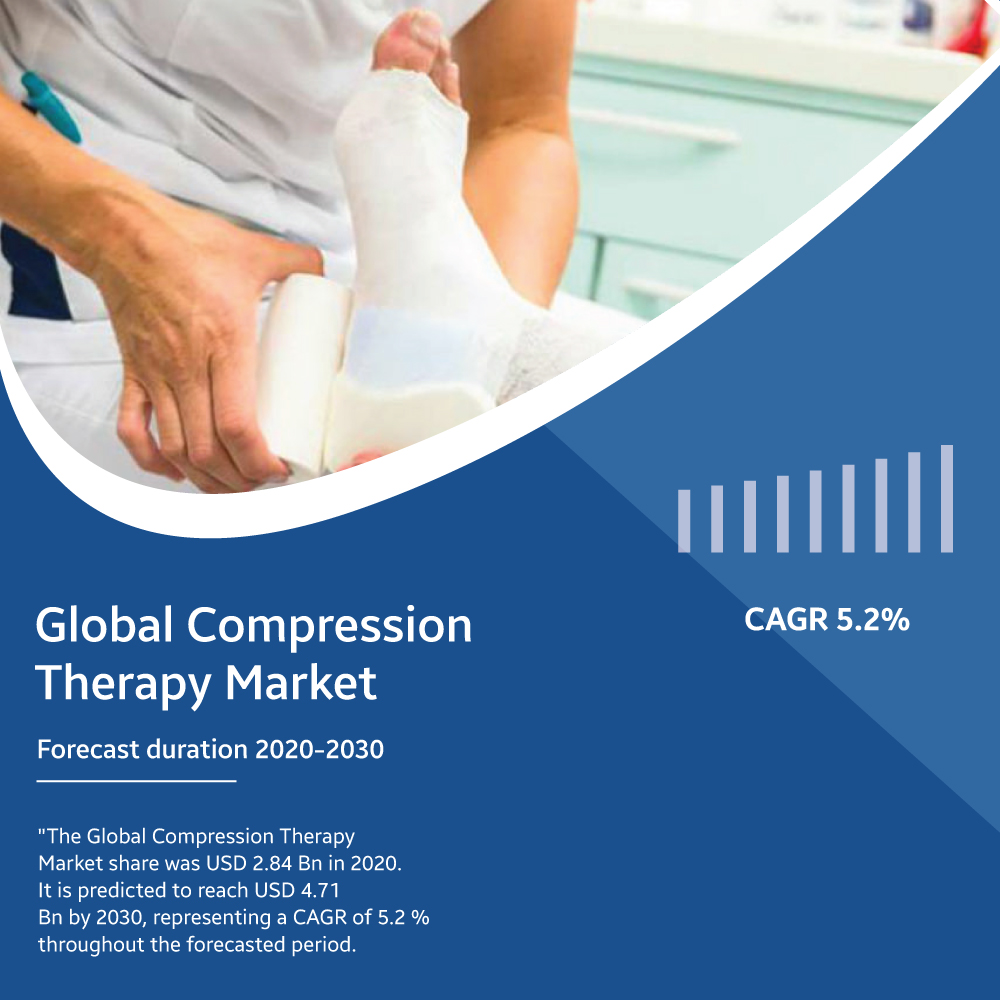Compression therapy is a technique that applies external pressure to particular body parts to treat a variety of medical conditions, including increasing blood flow through the area, reducing swelling, treating varicose veins, preventing orthostatic hypotension, and limiting movement of the part while maintaining blood flow in the event of a fracture or injury. Intermittent Pneumatic Compression (IPC) devices or compression apparel such as stockings, foot caps, sleeves, and gloves deliver therapy to the patient.
The market worth of compression therapy in 2021 was USD 2.98 billion and will be worth USD 4.71 billion by 2030 at a 5.2% CAGR.
Compression therapy is crucial for the treatment of ulcers and wounds. Intermittent pneumatic compression (IPC) devices, stockings, and bandages can all be used to deliver compression therapy. The market for compression therapy is driven by the rising prevalence of numerous conditions like chronic venous disease, angioedema, cirrhosis, and lymphedema; wearing compression gloves and stockings helps to avoid the accumulation of fluid.
Market Drivers
Athletes typically have bone and muscle injuries as a result of their excessive physical activity, which stresses their muscles, exhausts them and causes the body to produce lactic acid. This causes impaired venous return, varicose veins, fluid retention, and poor blood circulation. Compressive therapy equipment is increasingly being prescribed by physiologists and orthopedic surgeons to patients who exhibit these symptoms as a result of the increase in athletic competitions and sporting activities, which is anticipated to propel market expansion. Gloves, sleeves, and boots that exert pressure on the area where they are worn increase blood circulation. Additionally, it speeds up recovery after exercise by increasing the venous return of blood and lowering swelling and edema. Because of health advantages, athletes are using compressive therapy equipment more frequently.
Compressive therapy employing compressive cuffs, sleeves, stockings, and other garments is becoming more widely used, boosting market revenue. This is due to factors such as low cost, lack of infections, minimal side effects, and availability of treatment in the home.
Restraints
- People in underdeveloped nations are still ignorant of conditions like lymphedema that could restrict or impede the expansion of this sector.
- Additionally, an ineffective reimbursement plan for compression gear and therapeutic clothing hampered the market’s expansion.
Opportunities
The market value for compression therapy devices will increase due to emerging economies like China, Mexico, Brazil, and India. Elements including a larger patient population, an increase in disposable income, improved health infrastructure, and greater knowledge will significantly impact the growth rate of this industry.
Market Segmentation
On the basis of techniques, the market for compression therapy is segmented into dynamic therapy and static therapy.
Due to its great convenience and user-friendliness, static technology held a significant market share of 64.5% in 2022. This segment’s significant market share can be attributed to the increased accessibility of these goods in treating edema and sports-related injuries to provide pain and pressure relief. Benefits linked with static technology are also thought to drive the propensity of both patients and physicians, accounting for a sizable share.
On the basis of product, Compression bandages ruled the entire market in 2022, accounting for more than 43.8% of the market share. It is due to their widespread use in treating edema and lower limb venous and lymphatic problems. Bandages are believed to have advantages, including high-tension sustainability and high-cost efficiency, extensibility, and flexibility, that account for their widespread use in a variety of venous disorders.
Due to the rise in lymphedema and other venous illnesses, compression pumps will expand at a considerable CAGR. Pumps are additionally made to enable the delivery of controlled pressure in accordance with the severity of the disorder, making them more effective than the alternatives.
Regionally, 43.0% of the global market was ruled by North America in 2022. The increasing number of elderly people and obesity are responsible for the increase in this region’s share. In this region, the availability of advantageous government reimbursement programs and rising healthcare awareness are also important growth drivers.
Asia Pacific regional market will expand at the fastest rate. The market is fueled by significant R&D expenditures by key competitors and persistent efforts to commercialize goods at a substantially reduced cost. Furthermore, increased disposable income, which increases the likelihood of using these products, and continual improvement of healthcare infrastructure are expected to present lucrative growth possibilities for the market.
Key Players
- Smith & Nephew plc,
- 3M Company,
- Medtronic plc
- Spectrum Healthcare
- SIGVARIS,
- Paul Hartmann AG
- Bio Compression Systems Inc.
- Gottfried Medical Inc.
- Colfax Corp.
- Sigvaris Management AG
- BSN Medical GmbH
- Tactile Systems Technology Inc.
The market worth of compression therapy in 2021 was USD 2.98 billion and will be worth USD 4.71 billion by 2030 at a 5.2% CAGR. Because of developing technologies and increased disease prevalence, the worldwide compression therapy market will grow significantly.















































